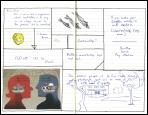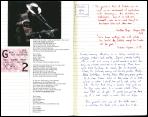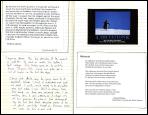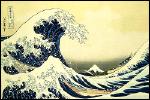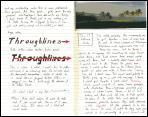I’ve just opened a new file in Google docs. A blank page confronts me. I’m stare at the screen. The cursor, a simple vertical black line, blinks at me, signaling a readiness, a willingness to begin. I stare at the screen. I’m thinking. It’s not that I don’t have ideas, I’ve got ideas up the wazoo, as my high-school classmates used to say, back in the day. The question is, which one? And why that one, and not one of the others?
I get up and go to the kitchen and retrieve my notebooks. (Well, four of them. The analog ones. On my computer there are notes in Word and Googledocs and Evernote and on my iPhone. And there are file cards and Post-its in little piles all over the place.) There are my two little pocket Moleskines, one for notes, one for sketches. There is my work notebook, where I take notes at meetings. And then there’s my personal journal, which I write in mostly on Saturday and Sunday mornings, right after I have done my morning exercises and right before I shower and eat. It’s my Saturday/Sunday journal because those are days when I have can usually count on having time to write that does not impinge upon other scheduled events, like making it to work on time. I do sometimes add stuff to the journal during the week, but usually it’s by pasting in something I’ve read or want to remember. This, for example:
Art is really an activity, and cannot be otherwise. There is no static art. Art is always an activity. And the fact that it ends up as a painting that somebody hangs on a wall is just a by-product of an activity. It’s not the activity itself. The real act, the real art, is the making of the art. And the real making of the art is a performance. Whether there’s people there watching you, or you’re doing it on your own, you’re moving around, you’re doing this thing and then that thing, you have an order to the way you work, there’s a body language at work in the way you stroke the canvas, there’s a sense of prioritizing of what big shapes and what little shapes, there’s always a sequence of some kind involved. Art is composition, and composition is always in time. It’s always a performance.
That passage is from a video interview on the web site of
George Woollard. I've been attending workshops with George for a couple of years now. He likes to talk while he works, and I discovered early on that what he had to say about art is not only interesting in itself but often has all kinds of resonances with what I have myself been thinking (and telling my students) about writing all these many years. So after the first few sessions I began using a digital tape recorder to capture his remarks. Then I’d transfer the digital recording to my laptop, plug in my earphones, open the file, open a new Word document, and then painstakingly transcribe the audio: listen to a sentence or two, click pause, type what I heard, click go. Repeat. Repeat. Repeat. (It generally takes me about three hours to transcribe a one-hour talk.)
There are a couple of benefits that arise from this process. One of course is that I get to hear the talk again, more or less in slow motion, and the act of transcribing the words brings them more deliberately into my brain. It’s nice to have the extra processing time. Even if I never re-read the transcripts, it’s still a good way for me to absorb what he was trying to get across. In fact, having the transcript available is not unlike having the painting to hang on the wall. It’s nice to have, but it’s not the activity itself. George’s point being, it’s the activity itself that is the art, and the art in its making is a performance. (As it is in writing. As it is even as I write this, doing this thing and then that thing, involving myself in a project of sequencing: let’s see, now where are we? And what comes next?)
Another spinoff benefit: my touch typing is way better than it was when I started. A third: I can take excerpts from the talks and fold them into other work, as I have done here, moving from one idea to the next.
I’ve been reading Stanley Fish. Chapter 6 of his most recent book,
How to Write a Sentence: and How to Read One, has a chapter on “The Additive Style,” which begins like this:
Sentences like Milton’s and Pater’s are not bashful about foregrounding the process of their own construction. They flaunt their artfulness and invite readers to share in the verbal pyrotechnics they display. But suppose you wanted to achieve another effect, the effect of not planning, order, and control, but of spontaneity, haphazardness, and chance. Then you might avail yourself of another style, no less artful, but marked by the appearance of artlessness. The fountain of this style is the French Essayist Michel de Montaigne... who announces (in “A Consideration upon Cicero”), “I write naturally and without a plan; the first stroke of the pen just leads to a second.”... [and] “I do not portray [finished] being; I portray passing...from day to day, minute to minute... This is a record of various and changeable occurrences, and of irresolute and, when it so befalls, contradictory ideas.” (“Of Repentance”).
What Montaigne says here echoes another of George’s core mantras: that you don’t need to know where you’re going. You need to know where you are:
So what you want to do is you want to embrace the process of composing. Composing, fabricating, creating the image. That’s what your job is. So as you try to figure out what you’re doing, this is what you do. You’re just putting one foot in front of the other. You’re walking through the composition, so all you really have to do is just decide what the next step is. You don’t have to know what the end product is. All you need to know is, okay, well, here I am.
Process Reflection: Well, this post is fairly transparently, I hope, an exercise in trying to relate and to apply a concept from the world of art to the world of writing. Another idea that George talks a lot about is the idea of linkage: that whether you are doing representational art or abstract art you begin at one point and then build outward from there, linking one move to the next. I started where I was, over there, up top, and worked my way forward. And now, here I am, over here. I’ve been making the argument with students and colleagues for years: this is what writing is about: facing a blank page and working your way into something. There are times when I (or my students) approach the blank screen or the blank canvas with a pre-set idea. But I find that what I (they) write on those occasions rarely satisfies me in the way that working in a more explorational way does. I didn’t know when I started what I was going to write about. But as I worked into it, the connections fell into place. It’s a process. It’s a performance. “Art is composition, and composition is always in time.” And so is writing.
Random Query: Did anyone else notice the colon in the title of the Fish book, and if so, does it create a disturbing ripple in your internal universe the way it does in mine?
Giving Credit Where Credit is Due: The proximate cause of me posting at all this evening was a
post by Ken Ronkowitz on
Weekends in Paradelle, one of a legion of really interesting blogs that Ken somehow manages to maintain, which basically embarrassed me in the nicest possible way into once again taking up the sword. Thanks, Ken.
Complaint Department: It looks like once again yet already Google docs has disabled the function that used to allow me to post directly from Google docs to my blog. So that means I have to copy, paste, and re-format everything to publish it. Color me unhappy about that. C'mon, guys. Please? Pretty please with sugar on top?















